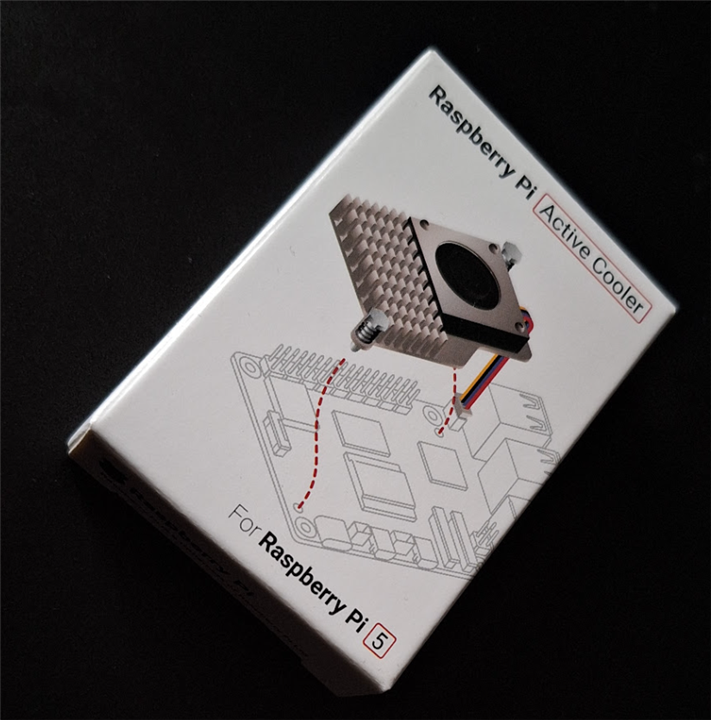Raspberry Pi Active Cooler for Raspberry Pi 5

The size of this box is about 1/6th of the volume of a Raspberry Pi 5 case, being about half its length and about the same width, and half its height.
The heatsink and fan itself is rather simple in its design.
I am surprised by the fan not pulling air over the heatsink fins, and those fins being rather uniform. I'm certain they help to pull heat away from the chips, but without active air going over all of it, I suspect its capability is a bit diminished.
The fan though, is over the top of where the processor lies, so that will be doing most of the work anyway. It has a 4 wire connection to the Raspberry Pi, allowing for feedback as to how fast it is spinning, along with control over how fast it spins. Including 5v power and ground.
The heatsink comes with three pads, probably to help level out the heatsink more than anything, but the areas to which it attaches are the power circuitry, wireless LAN shield and the processor. There are no pads on the RAM or RP1.
Now if we compare this to the Raspberry Pi Case for the Raspberry Pi 5, we only get a small heatsink, which is surprising considering the size and pads on the dedicated heatsink.
Now, you can still have the dedicated heatsink attached to the Raspberry Pi 5 and use the case, but you then need to disconnect the fan inside the case and throw away this small, now spare, heatsink.
I find it weird that the 'standalone' heatsink would be such a monster of size compared to what's suggested to use in the case, especially since inside a case you're going to want to pull away and move a lot more heat at once.
And no, you can't connect the case fan and the dedicated heatsink fan at the same time. If you want to, you can remove the fan from the dedicated heatsink and rely on the case fan instead, but that feels a bit weird. I'll have to do some benchmarks and tests to see what the best setup is.
Raspberry Pi Case for Raspberry Pi 5
The Raspberry Pi Case is very slick, it has a smooth, nice design and it comes apart really easily. If you have a Raspberry Pi 5 and want it to sit on your desk, this is something that will keep the dust off. Talking of 'off' though, I can see you will mainly keep the lid off if you want to be able to use anything significant, like the GPIO or keep the device cool.
The internal design is reasonably solid, giving good access to the GPIO header, and we have the introduction of an active fan cooler. We also have a small heatsink to apply to the processor to help wick that heat away, but as we observed, just why do we have a dedicated heatsink which attaches to more components, but the case doesn't appear to be designed for this?
Well in typical use the Raspberry Pi is probably fine with this setup, having the smaller heatsink and an active fan is likely more than enough if you're sitting with using the device as a desktop computer replacement or you're fiddling with your bits on the GPIO and bit-banging away, but if you want to do a bit more heavy lifting then you're likely going to need that more dedicated heatsink, and you will probably remove this secondary internal fan.
I think they possibly missed a trick without having a vent on the lid, if you want to keep your Pi cool, you're going to have that lid off most of the time because it impedes airflow and that might affect how fast your Raspberry Pi 5 runs, but ultimately we know that it will be perfectly safe and still function, even with it on, because of the smart way in which the device will scale back its speed to accommodate the temperature requirements.
I may just have to alter that fan header to see if I can run both at once though, it's a common 'hack' used on desktop computers, maybe it will apply here!
How will you use your Raspberry Pi 5?
HATS off, HATS on? Or will you have it sat with the lid on, coding away? What modifications do you want to do to the cooling of the Pi 5? Have you seen any other, custom coolers yet?
I'd be interested in knowing your thoughts.










